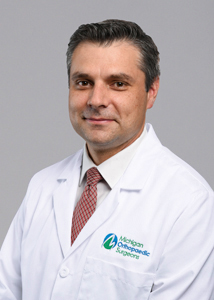Our experts are highly trained to help your hips.
Having hip pain? We can help. As the largest orthopaedic team in Michigan, our specialists perform hundreds of hip surgeries every year. And our positive outcomes are proven time and time again. Through our vast knowledge and innovative treatments, our experts have the power to heal your injury, no matter how it happened. So whether your hip pain is the result of trauma, overuse or aging, we’ll have you good as new in no time. You can trust us.
Conditions
Acetabular Dyslpasia
CAUSE
Acetabular dysplasia, sometimes called hip dysplasia, is a shallow, abnormally shaped, or improperly oriented socket. This type of anatomic configuration may contribute to instability of the femoral head within the acetabulum. And various alterations in the shape and orientation of the femur are now thought to contribute to hip instability.
Certain birth factors such as breech positioning, insufficient amnionic fluid and being the first born can be associated with hip dysplasia. Additionally, acetabular dysplasia can be caused by trauma to the acetabulum during childhood, or in association with Legg-Perthes disease.
WHO’S LIKELY TO GET IT
Acetabular dysplasia is a common congenital condition. It’s more frequent in females than males, and there is often a family history of hip arthritis.
SYMPTOMS
Most patients with acetabular dysplasia seek medical advice due to pain in the hip. Generally, the pain is located on the side of the hip and feels like muscle fatigue. However, groin pain, thigh pain and progressive limping are also common.
TREATMENTS
The treatment of acetabular dysplasia depends upon the extent of damage to the cartilage structures within the hip joint, and the age and activity level of the patient. Patients with severe damage to the cartilage structures of the hip joint are probably not good candidates for reconstruction, except in rare circumstances. Patients with limited cartilage damage and spherical hip joints are candidates for a periacetabular osteotomy. Occasionally, hip arthroscopy is used in conjunction with the periacetabular osteotomy to address areas of cartilage damage that may be detected using the preoperative MRI-arthrogram.
For post-operative pain relief, patients use a PCA (patient-controlled analgesia) pump containing narcotic medication for one night following surgery. Thereafter, they use oral pain medicine that is continued at home until the pain from surgery resolves. Most patients use some pain medicine for up to one month. Additionally, outpatient therapy is used when the patient returns home, in order to help restore strength and mobility.
Avascular Necrosis
Degenerative Joint Disease
Developmental Dysplasia of the Hip
Femoral Acetabular Impingement
CAUSE
Femoral acetabular impingement is the abnormal contact between the head or neck of the femur and the rim of the acetabulum. It has many causes, including abnormalities in the shape and orientation of the acetabulum, plus abnormalities in the shape and orientation of the femoral head and neck. And it’s thought to be the most common cause of adult hip arthritis. Other conditions, such as slipped capital femoral epiphysis (SCFE), Legg-Perthes disease, osteochondromatosis and prior treatment for hip dysplasia can also lead to femoral acetabular impingement.
SYMPTOMS
Most patients experience pain in the groin, thigh, buttocks or knee. Occasionally, the pain can be vague and involve the lower back, side of hip, or thigh. Mechanical hip problems such as clicking, locking and snapping are also common in femoral acetabular impingement. Some patients even report progressive loss of hip motion and difficulty performing activities such as crouching, squatting, prolonged sitting, walking and sleeping in certain positions.
Symptoms of femoral acetabular impingement depend upon the extent of associated damage to the hip joint. They can begin in the early teen years, but are most common in younger adults, ages 20 to 50.
TREATMENT
Treatment for femoral acetabular impingement is necessary if the patient has pain or signs of deterioration of the labral or joint cartilage. Surgical options include:
- A hip arthroscopy
- Surgical dislocation of the hip
- Periacetabular osteotomy
- A combination of the above procedures
With all options, the goal of surgical treatment is to remove any torn tissue, restore the normal mechanics to the hip joint and prevent the progressive deterioration of the hip joint.
Following your procedure, crutches and basic exercises will help you regain your hip mobility. Outpatient physical therapy will start after discharge and will help to further restore hip mobility and strength.
Hip Arthritis
Hip Loose Bodies
Hip Pain
Inflammatory Arthritis
Labral Tear
Osteoporosis
Snapping Hip
Synovitis
Treatments
Experts at Michigan Orthopaedic Surgeons offer the following treatment options:
- Osteoporosis Care
- Bone Grafting
- Femoroacetabular Impingement Surgery
- Hip Arthroscopy
- Hip Preservation
- Minimally Invasive Hip Surgery
- Non-operative Avascular Necrosis Treatment
- Osteotomies
- Revision Hip Surgery
- Total Hip Replacement
- Bilateral Hip Replacement
Doctors




Peter Donaldson MD
Elbow, Foot and Ankle, Hip, Knee, Nonsurgical Orthopaedics, Shoulder, Sports Medicine





